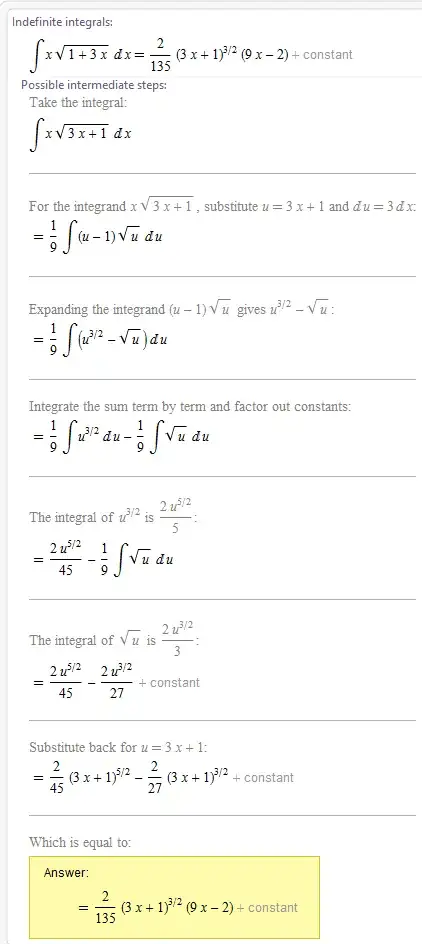I was trying to do the exercises in Apostol's Calculus. I tried to answer an exercise to find the indefinite integral of $\int x\sqrt{1+3x} dx$ via substitution. I've been able to do it via integration by parts, but with substitution, I have no clue on how to do it.
I've google for something and found this (here):
My problem is that according to the book, integration by substitution is based on the chain rule and hence:
$$\int f(g(x))g'(x)dx =F(g(x))+C\tag{1}$$
If I understood correctly, Apostol instructs to rewrite the function to be integrated on the form $f(g(x))g'(x)$ and then use $(1)$. My problem is that I don't see the form $f(g(x))g'(x)$ in the answer given by the link/image I provided, so I'm starting to think that the form $f(g(x))g'(x)$ may be something a little more complicated than I previously thought.
I have also tried to obtain a step-by-step solution with Mathematica/Wolfram Alpha. This elucidated a little more of what I was thinking:
Here, after making the appropriate substitutions, I also fail to see the form $f(g(x))g'(x)$ but there is an important point: It seems that the substitutions must be made in a way that if you substitute back, that is, if you put the $3x+1$ in the place of $u$ and $3$ in place of $du$, then after the expansion, it should become the expression you started with. This seems to be quite broader and vaguer than finding the form $f(g(x))g'(x)$, but it seems more honest (considering what I know at the moment). So, perhaps It's my stupidness, but where is the form $f(g(x))g'(x)$ in both these integration processes?
As an example of an integral where it's easy to see the form $f(g(x))g'(x)$, let's take:
$$\int x\sqrt{1+3x^2}dx$$
Then we can write:
$$\int \overbrace{6x}^{g'(x)}\overbrace{\sqrt{\overbrace{1+3x^2}^{g(x)}}}^{f(x)} dx$$
And from here, it would be easy to proceed. But in the two solutions I provided, I'm unable to see this form.

